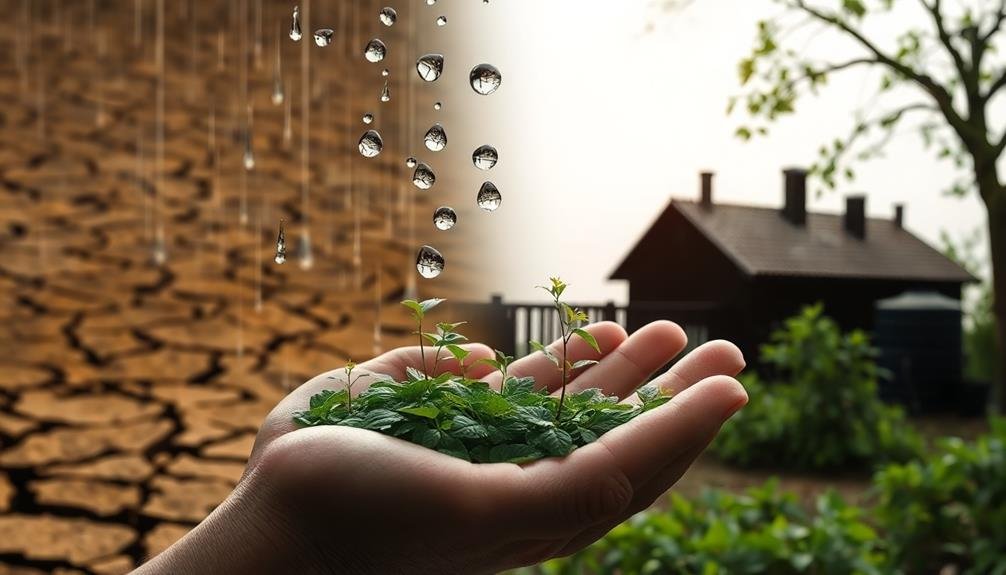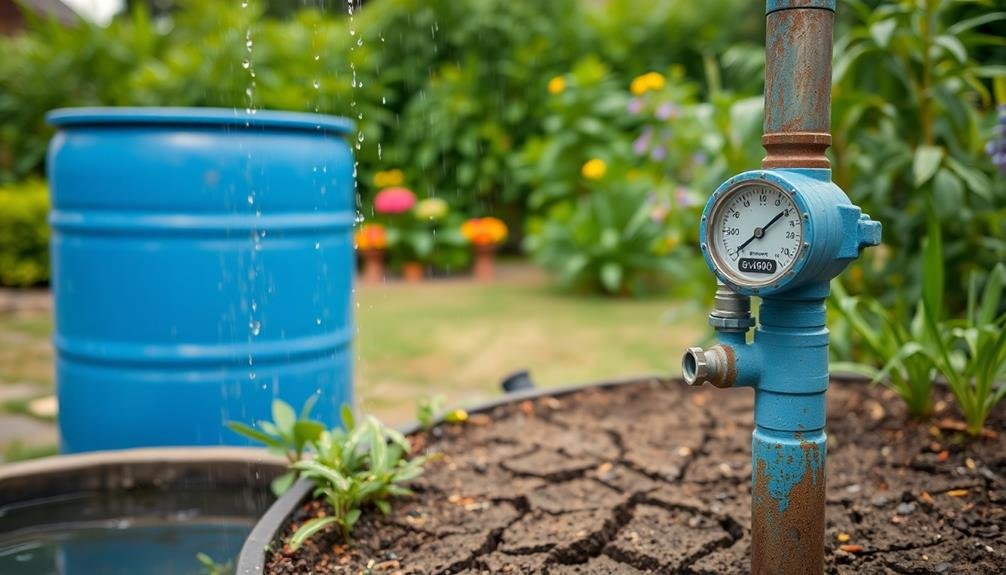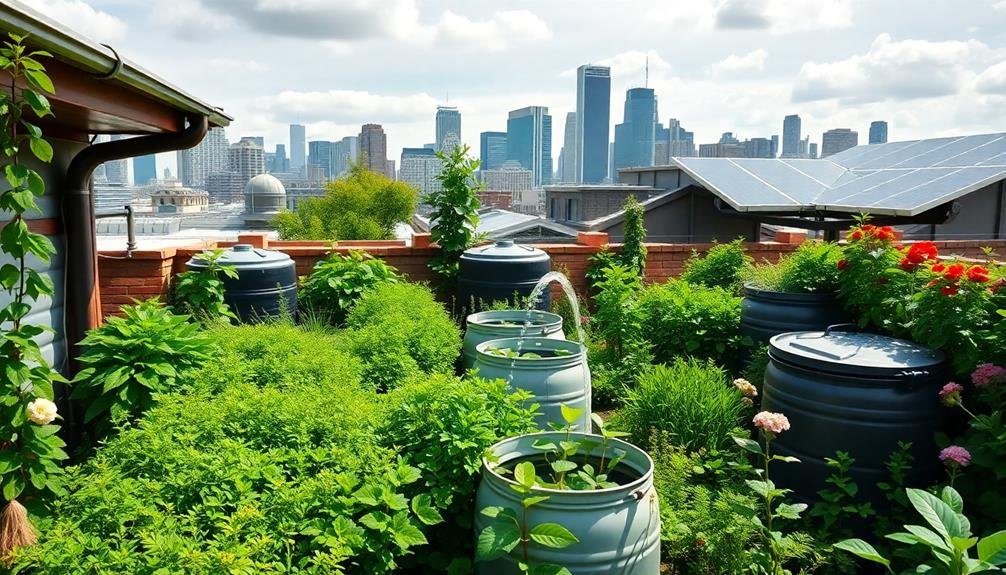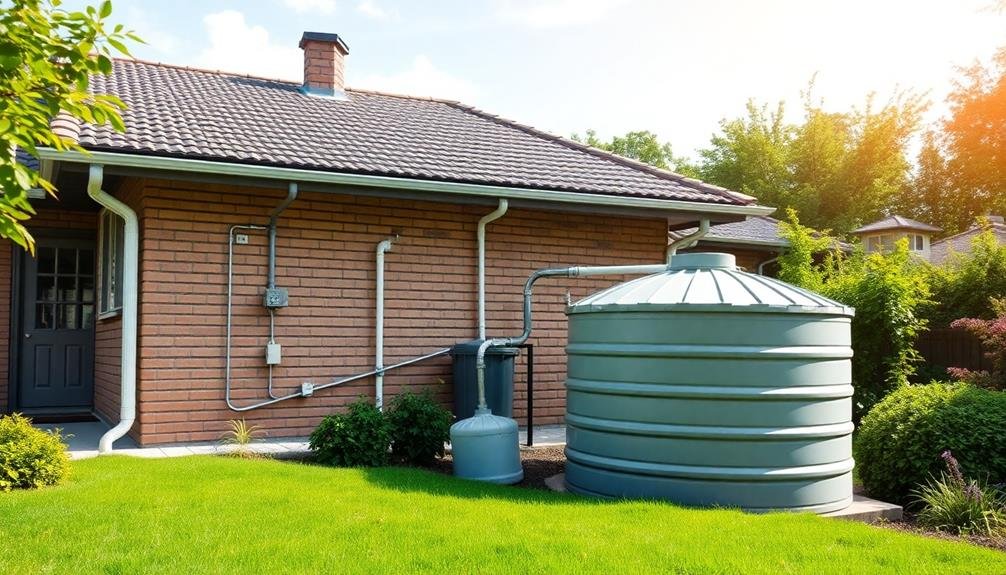Calculating energy savings from rainwater harvesting helps you understand its full impact on your property and the environment. You'll quantify reduced strain on municipal water supplies, lower carbon emissions, and decreased energy consumption for water treatment and distribution. This data allows you to assess the system's cost-effectiveness, estimate utility bill reductions, and set realistic sustainability goals. By measuring energy efficiency, you can determine the long-term financial benefits and environmental advantages of your rainwater harvesting system. These insights support informed decision-making and help justify the initial investment. Exploring the energy savings potential reveals a wealth of benefits beyond just water conservation.
Environmental Impact Assessment

The impact of rainwater harvesting on our environment can't be overstated. When you assess the environmental benefits, you'll find that this practice notably reduces the strain on municipal water supplies and decreases energy consumption associated with water treatment and distribution.
By collecting and using rainwater, you're effectively lowering your carbon footprint and contributing to water conservation efforts.
You'll notice that rainwater harvesting helps mitigate stormwater runoff, which can lead to erosion and water pollution. This natural filtration process also improves the quality of groundwater recharge.
When you implement a rainwater harvesting system, you're creating a sustainable water source that can be used for various purposes, from irrigation to household needs.
The environmental impact assessment of rainwater harvesting should consider factors such as reduced demand for groundwater extraction, decreased energy use in water pumping and treatment, and the potential for flood prevention.
You'll find that these systems can play an essential role in urban planning and sustainable development, offering a cost-effective and environmentally friendly solution to water management challenges.
Cost-Benefit Analysis
You'll want to evaluate the financial impact of implementing a rainwater harvesting system for energy savings.
Conduct a thorough assessment of initial installation costs, ongoing maintenance expenses, and potential savings on water and energy bills.
Calculating the return on investment will help you determine if the long-term benefits outweigh the upfront costs and guide your decision-making process.
Financial Impact Assessment
Numerous factors come into play when evaluating the financial impact of rainwater harvesting systems. You'll need to weigh initial installation costs, ongoing maintenance expenses, potential energy savings, and water bill reductions. It's essential to evaluate both short-term and long-term financial implications to make an informed decision.
Start by calculating your current water and energy costs. Then, estimate the potential savings from implementing a rainwater harvesting system. Don't forget to factor in any available government incentives or rebates that could offset your initial investment.
| Cost Factors | Savings Factors |
|---|---|
| Installation | Water Bill Reduction |
| Maintenance | Energy Bill Reduction |
| Equipment | Government Incentives |
| Upgrades | Increased Property Value |
When evaluating the financial impact, you'll want to determine the payback period – the time it takes for your savings to cover the initial investment. This can vary depending on your location, system size, and usage patterns. Remember, while the upfront costs may seem substantial, the long-term benefits often outweigh the initial expenses. By conducting a thorough financial impact evaluation, you'll be better equipped to make a sound decision on implementing a rainwater harvesting system.
Return on Investment
Building on the financial impact assessment, an extensive return on investment (ROI) analysis helps determine the true value of a rainwater harvesting system.
You'll need to evaluate both direct and indirect benefits when calculating ROI. Direct benefits include reduced water bills, lower energy costs for pumping and treating water, and potential tax incentives.
Indirect benefits may encompass improved property value, enhanced environmental reputation, and reduced strain on municipal water systems.
To calculate ROI, divide the net benefits by the total costs of implementing and maintaining the system.
Factor in the initial installation expenses, ongoing maintenance costs, and the system's lifespan. Don't forget to account for potential increases in water and energy prices over time, which can greatly boost your ROI.
You should also evaluate non-monetary benefits, such as increased water security during droughts or emergencies.
While these may be challenging to quantify, they're essential for a thorough ROI analysis.
Water Conservation Quantification

How much water can rainwater harvesting actually save? To quantify water conservation from rainwater harvesting, you'll need to take into account several factors. Start by calculating your roof's catchment area and the average annual rainfall in your region. Multiply these figures to determine the potential water collection volume.
Next, factor in the efficiency of your collection system, typically ranging from 70% to 90%. This accounts for losses due to evaporation, overflow, and first flush diversion.
You'll also want to take into account your storage capacity, as it limits the amount of water you can capture during heavy rainfall events.
To estimate actual water savings, analyze your current water usage patterns. Identify areas where harvested rainwater can replace potable water, such as irrigation, toilet flushing, and laundry. Track your water bills before and after implementing rainwater harvesting to measure real-world savings.
Don't forget to account for seasonal variations in rainfall and water demand. You may find that rainwater harvesting considerably reduces your reliance on municipal water during certain months while providing minimal savings in others.
Energy Efficiency Measurement
In addition to water conservation, rainwater harvesting systems can lead to significant energy savings. To accurately measure these energy efficiencies, you'll need to take into account several factors.
First, calculate the energy required to pump and treat municipal water that's being replaced by rainwater. This includes the electricity used for water treatment plants, distribution systems, and pumping stations.
Next, assess the energy consumed by your rainwater harvesting system. This typically involves the power needed for pumps to move collected water from storage tanks to points of use. Compare this to the energy that would've been used for municipal water supply.
Don't forget to account for the energy savings in wastewater treatment. Less water entering the sewage system means reduced energy consumption at treatment facilities.
You'll also want to take into account the long-term energy savings from decreased wear on municipal infrastructure.
To get precise measurements, use energy meters on your rainwater system's pumps and compare the readings to local utility data. Factor in seasonal variations and usage patterns for a thorough analysis.
Sustainability Goal Setting

Once you've measured the energy savings from your rainwater harvesting system, it's time to set meaningful sustainability goals. Use your energy efficiency data to establish realistic targets for reducing your overall environmental impact. Consider setting both short-term and long-term goals that align with your organization's broader sustainability initiatives.
Start by identifying areas where you can make the most significant improvements. Set specific, measurable objectives for reducing energy consumption, water usage, and carbon emissions. For example, aim to decrease your reliance on municipal water supplies by a certain percentage within the next year.
Don't forget to involve key stakeholders in the goal-setting process. Their input can help guarantee that your sustainability targets are achievable and aligned with your organization's priorities.
As you develop your goals, consider how they'll contribute to your overall sustainability strategy and corporate social responsibility efforts.
Remember to regularly review and adjust your goals as needed. As you implement new technologies or processes, you may find that you can set even more ambitious targets.
Utility Bill Reduction Estimation
To estimate your potential utility bill reduction from rainwater harvesting, you'll need to quantify the financial benefits.
Start by analyzing your water usage patterns to determine how much municipal water you can replace with harvested rainwater.
You can then calculate the cost savings based on your local water rates, helping you project the long-term economic impact of your rainwater harvesting system.
Quantifying Financial Benefits
Financial savings from rainwater harvesting can be substantial, but they're often overlooked. To quantify these benefits, you'll need to calculate the reduction in your water and energy bills.
Start by determining how much rainwater you can collect and use annually. This depends on your roof size, local rainfall, and storage capacity.
Next, estimate the percentage of your water needs that can be met with harvested rainwater. Consider both indoor and outdoor uses. Calculate the cost savings by multiplying this volume by your water rate. Don't forget to factor in any sewage charges you'll avoid.
For energy savings, focus on the reduced need for pumping and treating water. Estimate the energy required to deliver a gallon of water to your home and multiply it by the volume of rainwater you'll use. Convert this to kilowatt-hours and multiply by your electricity rate.
Add these water and energy savings together to get your total annual financial benefit. Remember to subtract any maintenance costs for your rainwater harvesting system to arrive at your net savings.
Usage Pattern Analysis
Analyzing your water usage patterns can shed light on potential utility bill reductions from rainwater harvesting. Start by reviewing your monthly water bills to identify seasonal fluctuations and high-consumption periods.
Pay attention to outdoor water use, such as lawn irrigation or pool maintenance, which can often be replaced with harvested rainwater.
Next, estimate the percentage of your total water consumption that could be substituted with rainwater. Consider uses like toilet flushing, laundry, and gardening.
Calculate the potential savings by multiplying this percentage by your average water bill.
Don't forget to factor in energy savings from reduced municipal water pumping and treatment. While these savings mightn't directly impact your bill, they contribute to overall energy conservation.
You can estimate these savings using local water utility data on energy consumption per gallon of water processed.
To refine your analysis, track your daily water usage for a month. Use smart meters or manual readings to create a detailed usage profile.
This data will help you pinpoint specific areas where rainwater can replace potable water, leading to more accurate savings estimates and informed decision-making about implementing a rainwater harvesting system.
Frequently Asked Questions
How Does Climate Change Affect Rainwater Harvesting Energy Savings Calculations?
Climate change impacts your rainwater harvesting energy savings calculations. You'll need to account for shifting rainfall patterns, increased temperatures, and extreme weather events. These factors can alter water availability and energy needs for pumping and treatment.
Can Rainwater Harvesting Systems Be Integrated With Existing Building Infrastructure?
You can integrate rainwater harvesting systems with existing buildings. They're adaptable to various roof types and gutters. You'll need to install storage tanks, filtration systems, and pumps. It's often easier during new construction but retrofitting's possible too.
What Are the Maintenance Requirements for Rainwater Harvesting Systems?
You'll need to regularly clean gutters, filters, and tanks. Check for leaks, inspect pumps, and treat the water if necessary. Don't forget to flush the system annually and monitor water quality. Proper maintenance guarantees system longevity and efficiency.
Are There Any Health Risks Associated With Using Harvested Rainwater?
You should be aware of potential health risks when using harvested rainwater. It can contain contaminants like bacteria, parasites, and chemicals. Always treat the water before drinking or cooking to guarantee it's safe for consumption.
How Do Local Regulations Impact the Implementation of Rainwater Harvesting Systems?
You'll find that local regulations can greatly impact your rainwater harvesting system. They may dictate system design, permitting requirements, and allowed uses for collected water. Check with your local authorities to guarantee compliance before implementing a system.
In Summary
You've now learned why calculating energy savings from rainwater harvesting is essential. It helps you assess environmental impact, analyze costs and benefits, quantify water conservation, measure energy efficiency, set sustainability goals, and estimate utility bill reductions. By understanding these savings, you'll make informed decisions about implementing rainwater harvesting systems. You're better equipped to contribute to water conservation efforts and reduce your energy footprint. Don't overlook this valuable tool in your pursuit of sustainable living and resource management.





Leave a Reply